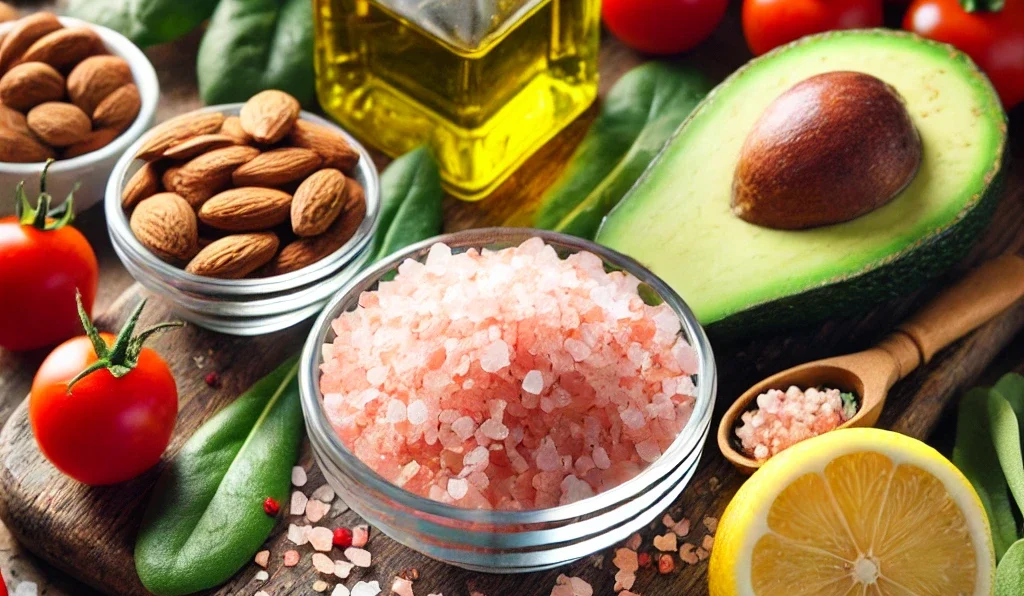Pink Himalayan salt, known for its striking pink color and rich mineral content, is often considered a healthier alternative to regular table salt. Sourced from ancient salt deposits in the Himalayan region, this salt contains a variety of essential minerals such as magnesium, potassium, and calcium, which contribute to its nutritional benefits. In addition to its culinary uses, pink Himalayan salt is valued for its potential health-promoting properties. Incorporating this salt into your diet or wellness routine can enhance both flavor and health in a natural, balanced way.
Health Benefits Of Pink Himalayan Salt
Mineral Content: Pink Himalayan salt contains more than 80 trace minerals, including calcium, magnesium, potassium, and iron. These minerals are essential for maintaining various bodily functions, including muscle function, bone health, and maintaining a healthy balance of fluids in the body.
Electrolyte Balance: The minerals in pink Himalayan salt can help maintain electrolyte balance in the body, which is important for hydration, muscle function, and overall health.
Supports Hydration: The mineral content of pink Himalayan salt can help maintain the body’s electrolyte balance, which is crucial for hydration. When consumed in moderation, it may help prevent dehydration, especially during exercise or in hot weather, by supporting fluid retention and electrolyte function.
Detoxification: Pink Himalayan salt is often used in detox baths because it’s believed to help draw out toxins from the body. When dissolved in warm water, the minerals in the salt can be absorbed through the skin, promoting relaxation, stimulating the lymphatic system, and aiding in the body’s natural detoxification process.
Respiratory Health: Inhaling the air from a pink Himalayan salt lamp or using salt therapy (halotherapy) is believed to improve respiratory health. The salt’s negative ions may help purify the air, reduce allergens, and improve breathing. Some people find relief from conditions like asthma, allergies, and sinus issues by spending time near a pink Himalayan salt lamp or using a salt inhaler.
Skin Care: The minerals in pink Himalayan salt can benefit the skin in several ways. Using it as an exfoliant in scrubs or adding it to bathwater can help cleanse and rejuvenate the skin. The salt’s detoxifying properties may help clear impurities and improve the overall appearance of the skin. Additionally, the high mineral content can support healthy skin regeneration and combat conditions like acne and eczema.
pH Balance: Pink Himalayan salt may help regulate the body’s pH balance by neutralizing excess acidity. By promoting a more alkaline environment in the body, it can contribute to better overall health and help reduce inflammation.
Promotes Better Sleep: The magnesium content in pink Himalayan salt can help promote relaxation and improve sleep quality. Magnesium is known to help regulate the production of melatonin, the hormone responsible for controlling sleep cycles. A small amount of pink Himalayan salt in your evening routine, such as in a warm bath or added to your drinking water, may help you wind down and get a more restful night’s sleep.
Uses of Pink Himalayan Salt
Culinary Uses: It is commonly used as a seasoning in cooking and as a finishing salt for various dishes. Many chefs and home cooks appreciate its flavor and texture.
Salt Lamps: Pink Himalayan salt is often used to create salt lamps, which are believed to purify the air and provide health benefits by releasing negative ions. While many enjoy the aesthetic appeal, the scientific backing for health claims is inconclusive.
Bath Salts: It can be used in bath products for its purported detoxifying and relaxing properties. Adding it to bathwater is thought to create a soothing soak.
Cooking and Serving Blocks: Pink Himalayan salt blocks can be used for grilling, chilling, or serving food, imparting a subtle salt flavor while also providing a unique presentation.
Safety Considerations
Sodium Content: Like all salts, pink Himalayan salt is primarily sodium chloride. It should be consumed in moderation, especially for individuals with high blood pressure or those on sodium-restricted diets.
Mineral Content: While it contains trace minerals, the amounts are generally small and may not significantly impact overall health. It should not be relied upon as a primary source of minerals.
Quality: The quality of pink Himalayan salt can vary. It’s important to purchase from reputable sources to ensure purity and avoid additives.
Storage: Store pink Himalayan salt in a cool, dry place to maintain its quality and prevent clumping.
Conclusion
Pink Himalayan salt offers more than just a flavorful addition to your meals; its impressive mineral profile provides several health benefits when used in moderation. From supporting hydration and digestion to promoting healthy skin and respiratory function, this pink-hued salt can contribute to your overall well-being. While it’s important not to overconsume any type of salt, incorporating pink Himalayan salt into your diet and self-care routine can be a natural way to support a healthy lifestyle.
